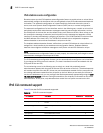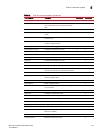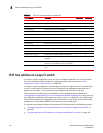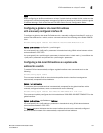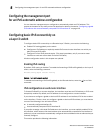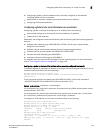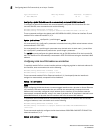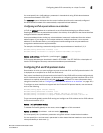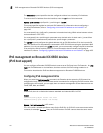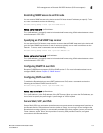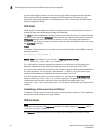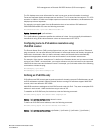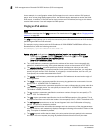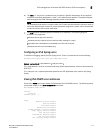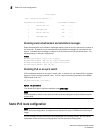
Brocade ICX 6650 Administration Guide 111
53-1002600-01
Configuring basic IPv6 connectivity on a Layer 3 switch
5
You must specify the <ipv6-address> parameter in hexadecimal using 16-bit values between
colons as documented in RFC 2373.
The link-local keyword indicates that the router interface should use the manually configured
link-local address instead of the automatically computed link-local address.
Configuring an IPv6 anycast address on an interface
In IPv6, an anycast address is an address for a set of interfaces belonging to different nodes.
Sending a packet to an anycast address results in the delivery of the packet to the closest interface
configured with the anycast address.
An anycast address looks similar to a unicast address, because it is allocated from the unicast
address space. If you assign an IPv6 unicast address to multiple interfaces, it is an anycast
address. On the Brocade device, you configure an interface assigned an anycast address to
recognize the address as an anycast address.
For example, the following commands configure an anycast address on interface 1/1/1.
Brocade(config)#interface ethernet 1/1/1
Brocade(config-if-e10000-1/1/1)#ipv6 address 2001:DB8::/64 anycast
Syntax: ipv6 address <ipv6-prefix>/<prefix-length> [anycast]
IPv6 anycast addresses are described in detail in RFC 1884. See RFC 2461 for a description of
how the IPv6 Neighbor Discovery mechanism handles anycast addresses.
Configuring IPv4 and IPv6 protocol stacks
One situation in which you must configure a router to run both IPv4 and IPv6 protocol stacks is if it
is deployed as an endpoint for an IPv6 over IPv4 tunnel.
Each router interface that will send and receive both IPv4 and IPv6 traffic must be configured with
an IPv4 address and an IPv6 address. (An alternative to configuring a router interface with an IPv6
address is to explicitly enable IPv6 using the ipv6 enable command. For more information about
using this command, refer to “Configuring a link-local IPv6 address on an interface” on page 110.)
To configure a router interface to support both the IPv4 and IPv6 protocol stacks, use commands
such as the following.
Brocade(config)#ipv6 unicast-routing
Brocade(config)#interface ethernet 1/1/1
Brocade(config-if-e10000-1/1/1)#ip address 192.168.1.1 255.255.255.0
Brocade(config-if-e10000-1/1/1)#ipv6 address 2001:DB8:12d:1300::/64 eui-64
These commands globally enable IPv6 routing and configure an IPv4 address and an IPv6 address
for Ethernet interface 1/1/1.
Syntax: [no] ipv6 unicast-routing
To disable IPv6 traffic globally on the router, enter the no form of this command.
Syntax: ip address <ip-address> <sub-net-mask> [secondary]
You must specify the <ip-address> parameter using 8-bit values in dotted decimal notation.
You can specify the <sub-net-mask> parameter in either dotted decimal notation or as a decimal
value preceded by a slash mark (/).




